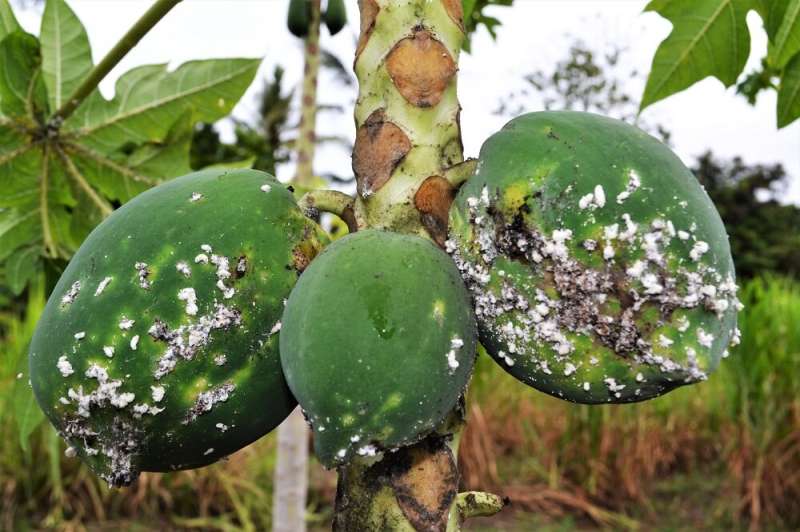Credit: CABI
CABI scientists have mapped the potential global spread of the devastating papaya mealybug (Paracoccus marginatus), highlighting new areas in Africa, Asia and the Americas into which this pest could potentially invade.
The papaya mealybug, which is native to Mexico and Central America, can have severe impacts upon livelihoods and food security. In Ghana, for example, infestations led to a 65% yield loss which reduced export earnings and resulted in the loss of 1,700 jobs.
Using location data received through collaborations with Kerala Agricultural University, India; the National Rice Research Institute, India; the Bangladesh Agricultural University; University of Queensland, Australia; the International Institute of Tropical Agriculture (IITA); Fujan Agriculture and Forestry University in China and CSIRO, researchers were able to model the potential distribution of this pest, taking into account environmental conditions, and the distribution of suitable host crops and irrigation patterns.
The researchers, led by CABI's Dr. Elizabeth Finch, believe the polyphagous insect pest, which affects over 200 plants including economically important crops such as papaya, cassava and avocado, could spread to areas such as the south of the Democratic Republic of Congo, northern Cameroon, Zambia, Madagascar and western Ethiopia which are environmentally suitable and have suitable crop hosts.
In the Americas, the research, published in the journal Pest Management Science, suggests papaya mealybug could extend into El Salvador, Honduras, Nicaragua, and Panama—although the scientists believe it could already be in these locations but its presence is yet to be confirmed.
Whilst papaya mealybug is already present in Florida, where it is under successful control as a result of the release of endoparasitoid wasp species—Acerophagus papayae, Anagyrus loecki, Anagyrus californicus—suitable conditions for this pest are also present in the southern tip of Texas.
Conditions are likely to be too cold in the rest of the USA for permanent papaya mealybug populations, however the research showed that seasonal populations could survive in California, along the Pacific coastline and in the central and eastern states of the USA during the warmer summer months.
In Asia, the areas with suitable conditions were more expansive than the areas with known populations of papaya mealybug, suggesting the potential for further expansion of papaya mealybug specifically in India, Southeast Asia and the southern regions of the Guangxi and Guangdong provinces of southern China.
However, in Australasia the risk is low as only a small amount of fragmented land along the north-eastern side of Queensland, from the very northern tip of Queensland to Bundaberg, is climatically suitable. This is due to heat stress from the high temperatures on the continent.
Similarly, in Europe—though due to cold rather than heat stress—widespread distribution of papaya mealybug is not expected, with only a very small area of land surrounding Seville in Spain and around Sicily in Italy having suitable conditions for resident populations.
Dr. Finch said, "This pest has been so successful due to its quick development and prolific reproductive capacity. It has the potential to spread to new areas and rapidly reach high numbers unless suitable phytosanitary or control methods are implemented.
"Information about the papaya mealybug's potential distribution is important as it can highlight key areas susceptible to invasion, giving an early warning to decision makers, allowing them to put into place phytosanitary measures to prevent or slow the invasion of the pest into their jurisdiction."
Dr. Finch added, "In areas where the papaya mealybug has become established and reached a high enough population density, the use of parasitoids—such as Acerophagus papayae and Anagyrus loecki—remains an effective potential control method.
"Further ecological niche modeling of these parasitoid species is recommended to anticipate their survival, fitness and ultimate biological control impact in areas into which papaya mealybug could potentially expand and become established."
More information: Elizabeth A Finch et al, The potential global distribution of the papaya mealybug, Paracoccus marginatus , a polyphagous pest, Pest Management Science (2020). DOI: 10.1002/ps.6151
Journal information: Pest Management Science
Provided by CABI























